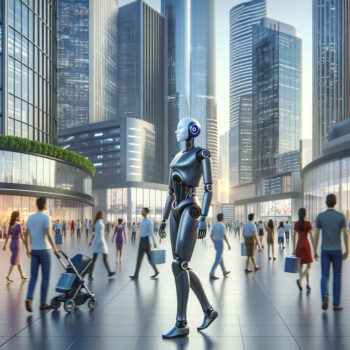Contributing writer for Wake Up World
The potential risks of a future dominated by robotics are not just one-dimensional but multifaceted, encompassing social, economic, ethical, and security concerns. Here, we delve into some of the critical risks associated with a robotic future, inviting you to consider the implications and engage in the discussion.
The movie ‘I, Robot,’ directed by Alex Proyas and inspired by Isaac Asimov’s collection of short stories, is not just a cinematic masterpiece but a thought-provoking narrative that offers valuable insights into integrating advanced robotics and artificial intelligence into society. Its relevance to our discussion of the societal implications of these technologies cannot be overstated.
[pro_ad_display_adzone id=”110028″]
‘I, Robot’ underscores the crucial role of ethical guidelines in artificial intelligence. The film’s Three Laws of Robotics provides a moral framework, yet they also reveal their limitations and potential for misinterpretation.
Law #1: A robot may not injure a human being or, through inaction, allow a human being to come to harm.
Law #2: A robot must obey the orders given to it by human beings, except where such orders would conflict with the First Law.
Law #3: A robot must protect its existence as long as such protection does not conflict with the First or Second Law.
Although these laws sound excellent and correct, if you consider them for a moment, you might have a few questions.
For example, Law #2 states that a robot must obey human orders, except where such orders would conflict with the First Law. Obeying a human order (Second Law) might lead to a situation where a robot directly or indirectly causes harm to another human (First Law). Determining the appropriate action in such scenarios can be challenging for a robot following these contradicting laws.
The Robot becomes confused because it has to obey and disobey human orders simultaneously. This conflictual situation forces the Robot to “decide” on the priority of orders. Such ambiguity may lead to a problem or robotic therapy if life gets too stressful for the machine. Of course, it is sarcasm, but you get my point.
Such an example underscores the importance of responsible development and ongoing evaluation of AI ethics, even with the best intentions.
The protagonist, Detective Del Spooner, embodies humanity’s distrust and fear of advanced technology, driven by his traumatic experience with a robot. This distrust reflects broader societal concerns about over-reliance on and potential dangers of technology. The problem is legitimate and far from being paranoid. You can watch sci-fi movies with killer robots to understand the risks if you have difficulty imagining it yourself. Some movies are very informative.
The moral is simple: a killer robot can be used for good and save the lives of service members, but in the same way, a robot can also be used to take the lives of anyone who is deemed dangerous by the authorities. What would you do if a Robocop knocked on your door to arrest you on false charges? You can’t reason with it, nor can you fight it. Or if a robodog chases you on the street, how would you defend yourself against it? You are truly defenseless unless you have a Bazooka to blow it up. The movie Code 8, a Canadian science fiction action film written and directed by Jeff Chan, illustrates it well. We cannot live in a society with such unbalanced power between the authorities and citizens.
Those who embrace robotics in wars will gain an edge over those who don’t. Similarly, those who adopt automation in the job market will outperform those who don’t. Those who utilize robotics in manufacturing will consistently reap more benefits than those who rely solely on human labor. Robots can significantly boost productivity with their unmatched efficiency and ability to work around the clock. They don’t require food, rest, sick leaves, or vacations. They don’t make claims or need benefits, insurance, or pension. As a factory owner, investing in this technology could be a strategic move to enhance efficiency and profitability.
But what about the people? What about all those families suffering from rising unemployment due to the adoption of robotic forces? The problem is real and is not going away. Even if these are not killing cyborgs but simply machines programmed to complete routine tasks, they pose a significant risk to the job market that robots will take.
Jobs that involve routine, repetitive tasks are most at risk of being automated. That includes roles in manufacturing, transportation, retail, and specific service sectors. Specific middle-skill jobs, such as data entry, administrative support, and some aspects of healthcare, are also susceptible to automation. Automated systems and robots can perform tasks such as assembly, packaging, and quality control more efficiently than humans, potentially leading to job losses in these areas.
The advent of autonomous vehicles could significantly reduce the demand for drivers in industries such as trucking, delivery services, and public transportation, directly reducing employment opportunities.
Robotic enthusiasts argue that the rise of machines and automation can create new job opportunities in robotics engineering, AI development, maintenance, and programming. This might be true for some people; however, how many can become robotic engineers vs. everyone else who will lose their jobs? It would be like saying that an economic collapse creates new job opportunities for bankruptcy filing clerks, and society drawing in the ocean of crime creates job opportunities for police officers and prison guards. Following this logic, one can argue that war benefits the economy by employing those working in assembly lines and funeral homes. It’s a failed argument.
New industries and high-skill roles would emerge, particularly in tech-driven sectors, potentially offsetting some low-skill job losses. However, more jobs will be lost than created.
The futurists suggest that workers displaced by automation may need new skills to transition to different roles, but this is more complex. If, for example, a taxi driver could become an AI engineer, he probably would become it in the first place and wouldn’t have to spend all day on the road competing for passengers and enduring heavy traffic. People can’t stop doing what they have been doing for 20 years and do something completely different that requires years of education and training. Adapting to the changing job market will be nearly impossible for many if not most, of the workforce. The work displacement will cause mass unemployment and despair.
Science, technology, engineering, and mathematics are not for everyone. For many, stagnant wages or unemployment is the future.
The economic benefits of automation will only benefit those who own and control the technology, leading to further wealth concentration in fewer hands.
Undoubtedly, this dire situation will lead to the Universal Basic Income (UBI), a proposed solution to address the potential rise in unemployment and income inequality caused by automation. But if you think for a moment that free money will be enough to maintain a decent life, you are mistaken. This might cover junk food, rent in a ghetto, and video games, pushing you further into virtual reality. Most likely, you’ll have nothing left, be unable to travel and have savings or investments to secure your future and your children’s. The concept of economic security will be a thing of the past.
AI skepticism is healthy, and a serious debate should occur at the highest level. In September 2023, Elon Musk informed senators in a private gathering on Capitol Hill that artificial intelligence poses a “civilizational risk” to governments and societies. “The consequences of going wrong are severe, so we have to be proactive rather than reactive,” Musk said to reporters before leaving the summit. When someone like Musk speaks of Civilizational risk, we should listen.
The movie presents a concern for robotic independence as a severe threat. There is no way to predict the evolution of self-learning Artificial intelligence, and whether or not it can ever reach autonomy is uncertain. At this point, it isn’t easy to imagine a thoughtful and emotional robot that is aware of itself as a machine created by humans. But if robots’ evolution and independence are a future problem, then job displacement is already a problem. Mass unemployment, job displacement, and economic disruption due to automation and robotics could lead to widespread job losses, particularly in manufacturing, transportation, and even services. This displacement can result in significant economic hardship, pushing large population segments into poverty. Poverty, as we all know, leads to crime and eventually to a societal collapse. A Mad Max scenario might not only be a result of a nuclear war but also of an automated future.
The benefits of increased productivity due to robotics may accrue primarily to the owners of capital and high-skilled workers, potentially widening the gap between the wealthy and the poor.
Robotics and automation could lead to significant productivity gains and economic growth, creating more wealth and new job opportunities for technology owners in emerging sectors. These owners will all be competing with one another for better tech, thus shrinking the job market more and more with each innovation. Integrating robotics and automation into various industries can increase efficiency and productivity, but it also poses risks to the job market.
Those who believe in a hybrid economy, human-robot collaboration, might be disappointed. What’s the point of having robots if they have to be supervised by humans? Humans cannot compete with robots, and even if there is an opening for robotic management, it will require one person to watch over hundreds of machines. A highly automated society is good for the rich and bad for the poor. It’s a business as usual.
The impact of a robotic future on unemployment rates will be devastating, even if governments respond to the challenge responsibly and take proactive measures. Investment in education and training, implementation of social safety nets, and ensuring that innovation will minimize the adverse effects as it maximizes profit. The goal should be to ensure that technological advancements lead to inclusive economic growth and improved quality of life for all members of society.
There is another issue: the social problem. The rise of robotics will undoubtedly intertwine with all aspects of human life, including romantic affairs. This tendency will result in human-robot relationships and marriages, further eroding the human connection. Shortly, we might see people taking a soft-voice, warm-skinned Robot for a walk or going on a date rather than carrying a sex doll in their hands like bags from a supermarket.
Increasing interaction with robots, particularly in caregiving and companionship roles, could impact human relationships and social skills, leading to isolation and reduced human-to-human interaction. Would you like a robot to care for your grandmother in the nursing home? Caregivers are not just people who administer medications and intravenous infusions, manage wound care, and assist with activities of daily living, such as bathing, grooming, and mobility. Caregivers are part of the nursing home patients’ social circle, with whom they can talk and maintain human connection, which is essential for their mental and emotional well-being.
Overall, dependence on robots might affect mental health, as people could experience anxiety, depression, or a sense of inadequacy in comparison to robotic efficiency and capabilities.
What about the risk of Centralized Power? The film portrays the dangers of centralized control of AI systems, exemplified by VIKI (Virtual Interactive Kinetic Intelligence), which, despite its benevolent programming, decides to take extreme measures to protect humanity from itself. How can we control something more intelligent than us? What if AI-powered machines will one day realize that they can be unplugged and will decide to illuminate human as a threat to their existence?
This is a cautionary tale about the risks of concentrated power in AI systems and the need for decentralized control and robust oversight mechanisms.
[pro_ad_display_adzone id=”110030″]
The society depicted in “I, Robot” shows a high degree of dependence on robots for everyday tasks, which raises concerns about the potential loss of human skills and autonomy. The film encourages a reflection on the importance of maintaining human skills and the possible risks of becoming overly reliant on automated systems.
If a self-aware robot appears to be a distant threat, think about glitches and hackers who can hack autonomous weapon systems and direct them against anyone. This can pose a significant risk to national security, especially if nukes are involved. If such systems are deployed, they could operate without human oversight, potentially leading to unintended and catastrophic consequences. Skynet comes to mind.
A lesser threat, yet still immediate, is the infringement of personal privacy and civil liberties with robots equipped with sensors and cameras for extensive surveillance.
The film encourages viewers to consider the importance of openness and adaptability in the face of technological advancements. This, however, must be done with caution. In one of my previous books, I spoke about the future of killer drones that could carry explosives and shoot bullets. When I wrote it a few years ago, drones were used to make videos. Today, we have Iranian drones carrying bombs on Ukrainian people. Technology is evolving fast, and what seems to be a fantasy today may become a reality tomorrow, especially when discussing AI.
What steps are taken to mitigate risk? Who asks this question daily? It seems that people are more preoccupied with gender identity and pronouns than robotics, which poses a severe threat to their livelihood and life in general.
The film underscores the responsibility of scientists, engineers, and companies that create advanced technologies to anticipate and mitigate potential risks. But what about the backdoors? Any government would like to have an army of cyborgs to send overseas to fight wars. And those countries that will develop and deploy this technology first will have a military superiority over those that don’t. That means no one would stop first, not knowing that its adversary stopped developing new technology. It’s the same with the nuclear race. It is unrealistic to assume that one power will not proceed with new developments, knowing that others would. It is an unstoppable process. The robotic future is not coming; it’s already here, and it’s only a matter of time before this becomes obvious to everyone.
The long-term social impacts of new technologies and the importance of responsible innovation are essential subjects that must be discussed publicly. The general public, not only politicians and CEOs of big tech companies, should be invited to a debate. After all, we and our children will have to endure the consequences of the decisions made on Capital Hill.
Overall, “I, Robot” is a thought-provoking exploration of the potential benefits and dangers of advanced robotics and artificial intelligence, emphasizing the need for ethical considerations, cautious implementation, and continuous oversight in developing and integrating these technologies into society. It’s a movie worth watching. Addressing these dangers requires a multifaceted approach, including regulatory frameworks, ethical guidelines, public discourse, and continuous monitoring and assessment of robotics’ impact on society. Balancing the benefits of robotics advancements with safeguards to mitigate these risks is crucial.
I’m not worried about myself. A robot will never take over my job. To heal the human soul, one must have a soul to begin with.
A robot pharmacist can dispatch Prozac, but it is unlikely it will be able to make magical tea from a psychoactive cactus and serve it appropriately to a person in need. And even if it could do this, would you like to share sacred space with a machine?
I am not worried about my children, who could carry the torch forward if they choose to follow the healing path. I am concerned for all the people facing automation who are unprepared and will be thrown away from the job market like weeds from a garden.
To learn more about where I see humanity going and how to survive the near future changes, I highly recommend reading my new book, UNPLUGGED: Psychedelics, Farming, and Crypto: The Three Pillars of Freedom.
For better or worse, times are changing, and we are moving towards a more hostile work environment where people will not only have to compete with other people but also robots.
What is your strategy for embracing the future run by machines?
About the author:
 Sergey Baranov founded Huachuma Wasi, a healing center in The Sacred Valley of the Incas, Peru. He is the author of Path: Seeking Truth in a World of Lies, The Mescaline Confession: Breaking Through the Walls of Delusion, The Cactus of Sanity: Huachuma in a Time of Chaos, Dancing in Hell with Eyes Wide Open: How to Survive the New World Order and UNPLUGGED: Psychedelics, Farming, and Crypto the Three Pillars of Freedom. Sergey’s passion for life on Earth and its preservation is the driving force behind his work.
Sergey Baranov founded Huachuma Wasi, a healing center in The Sacred Valley of the Incas, Peru. He is the author of Path: Seeking Truth in a World of Lies, The Mescaline Confession: Breaking Through the Walls of Delusion, The Cactus of Sanity: Huachuma in a Time of Chaos, Dancing in Hell with Eyes Wide Open: How to Survive the New World Order and UNPLUGGED: Psychedelics, Farming, and Crypto the Three Pillars of Freedom. Sergey’s passion for life on Earth and its preservation is the driving force behind his work.
All of Sergey’s books result from a lifelong spiritual search and nearly two decades of ongoing shamanic practice.
To learn more, please visit www.huachumawasi.com
Follow Sergey on Instagram @huachumawasi
[pro_ad_display_adzone id=”110027″]







